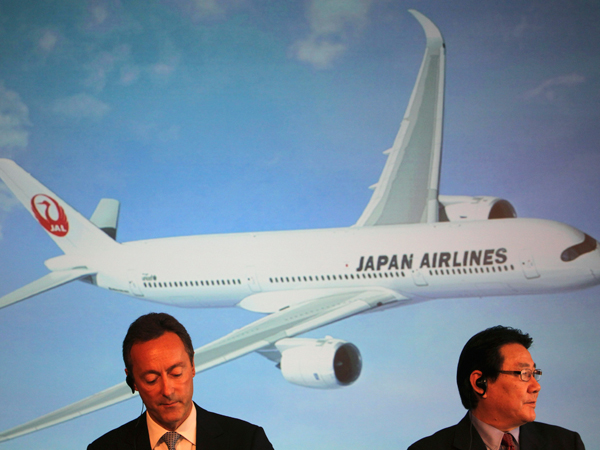
Airbus Japan Chief Executive Fabrice Bregier, left, and Japan Airlines President Yoshiharu Ueki, right, attend a press conference in Tokyo, Monday, Oct. 7, 2013, to announce Japan Airlines is buying its first ever jets from Airbus with a purchase of 31 A350 planes. The entry of new wide-body passenger planes capable of carrying large loads of cargo is slowing down a recovery in the struggling air freight business, the International Air Transport Association chief said Wednesday, Oct. 17, 2013. AP
SINGAPORE—The entry of new wide-body passenger planes capable of carrying large loads of cargo is slowing down a recovery in the struggling air freight business, the International Air Transport Association chief said Wednesday.
An increasing number of larger planes such as the Boeing 770-300 ER and Airbus A330-300, catering to growing passenger numbers, has led to an oversupply of cargo capacity at a time when demand for freight transport is lean, said IATA Director General Tony Tyler.
“Every time a new wide-body passenger aircraft takes to the air, it brings with it significant cargo-carrying capacity,” he told reporters in Singapore.
“With (cargo) demand being weak, and capacity supply growing, what you see is competition forcing yields down,” said Tyler, who is in the city-state to attend an international air freight conference.
In September IATA cut its forecast for growth in air cargo traffic this year to 0.9 percent, down from an earlier estimate of 1.5 percent, while predicting that passenger demand will grow at 5.0 percent in 2013.
The Canada-based industry group said, however, that it expects a significant improvement in global cargo growth to 3.7 percent next year.
Meanwhile, Asia-Pacific freight carriers, which have been impacted by slowing demand for goods manufactured in the region, are facing stiff competition from Middle East rivals, Tyler said.
The latest IATA data showed Asia-Pacific airlines’ freight demand declined 0.2 percent in August compared to the previous year, while Middle Eastern carriers saw growth of 23.8 percent in the same period.


